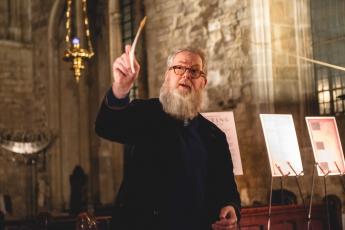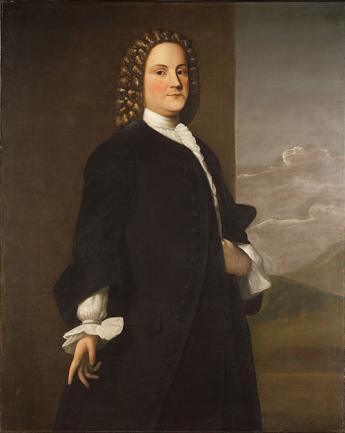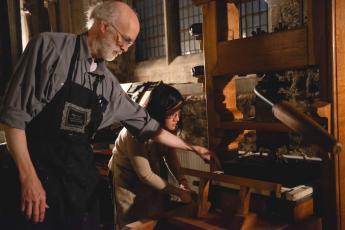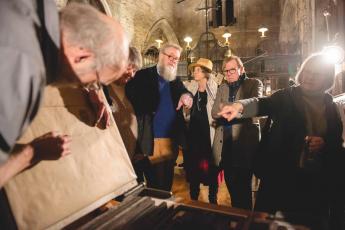News & Updates Bryars & Bryars
Benjamin Franklin, London Printer

A guest post by Tim Bryars.
This year marks the 300th anniversary of Benjamin Franklin’s first visit to London. At St Bartholomew the Great we have special reasons for celebrating.
Remembered as an inventor, diplomat and a Founding Father of the USA, Benjamin Franklin always described himself as a printer. As a boy he ran away from his apprenticeship with his brother James in Boston, which caused a serious family rift, and he worked for another printer in Philadelphia. By the time he was 18 he had tired of working for the eccentric Samuel Keimer, on a beaten-up press with worn-out type. He thought he had secured a powerful patron in the person of Pennsylvania governor Sir William Keith, although Keith’s letters of recommendation turned out to be worthless. Without money or influential friends he crossed the Atlantic to learn from the leading printers in London, which was the centre of the print trade in the English-speaking world. He arrived on Christmas Eve 1724.

Which is where we come in. The ancient Lady Chapel of St Bartholomew the Great is one of two places in the country where the Virgin Mary is said to have appeared, but it had been separated from the rest of the church at the Reformation, and in 1725 it housed the printing shop of respected master printer Samuel Palmer, who gave Franklin his first job in London.
In February 2025 specialist hand press printers will operate a working replica of the ‘Franklin press’ on the exact spot where Franklin mastered the art of printing 300 years ago. The original Franklin press, which Franklin used in London in 1725, is now in the Smithsonian Museum in Washington, but we are borrowing a working reconstruction from the University of Reading.
Franklin worked for Palmer as a compositor, or typesetter, one of the most skilled jobs in any printing shop. Individual letters of metal type – and the spaces between – were set character by character, backwards, in a wooden frame. It was piecework rather than paid by the day or week, so both speed and accuracy were essential. From his Autobiography we know that he set the type for the third printing of Wollaston’s Religion of Nature Delineated, a controversial theological work which influenced Enlightenment thought in both Britain and America. An example of the book will be on display.
We’ll also be displaying a 1930 facsimile of Franklin’s ‘Dissertation on Liberty and Necessity‘, composed in 1725 and printed by Franklin on Palmer’s press as a personal response to the ‘Religion of Nature Delineated‘, the book which Franklin worked on as a typesetter. At this time in his life Franklin may have been a deist: he believed in God, but as a creator remote from human affairs. Palmer took Franklin ‘to task’, describing his pamphlet as ‘abominable’ and Franklin came to regard it as ‘another error’ of his life: he burned every copy he could find (bar one), and only five copies now survive in libraries worldwide.
19 year old Franklin was a long way from the celebrity scientist, man of letters and passionate advocate for the American colonies which he had become by the time of his second residence in London. He lived in Craven Street between the 1750s and 1770s, for two decades rather than a little under two years, and it’s easy to overlook his first visit. However, Franklin’s early experiences in Hogarth’s London helped shape his later life. William Hogarth was baptised in St Bartholomew the Great, and he and Franklin walked the same streets at the same time. It was also the London of Joseph Addison’s Spectator, published 1711-1714, which influenced Franklin’s thinking and style from the day an odd volume fell into his hands as a boy in Boston. Franklin’s artisan background already set him apart from the wealthier Founding Fathers, but he was older too, and his exposure to the poverty and politics of Georgian London, so memorably recorded in their different ways by Hogarth and Addison, gave him a perspective which was unique among the other founders of the United States.
Find out more about the programme celebrating Benjamin Franklin’s time at St Bart’s the Great in 1725-26. This includes talks and demonstrations of a replica contemporary printing press.


This article was first published on the LONDON HISTORIANS' BLOG and was reposted here by permission of the author as well as the blog's editor.
The original article can be found >> HERE
Images of the launch event by Carla Salvatore
